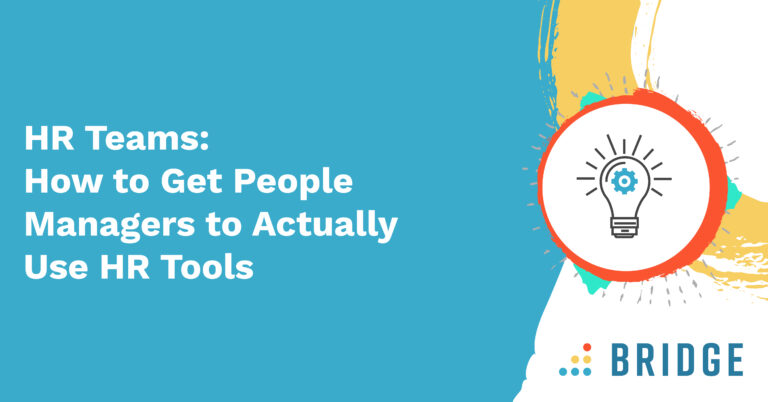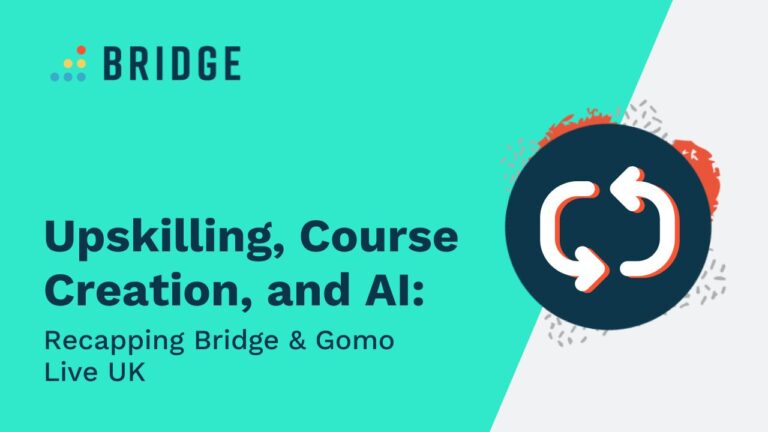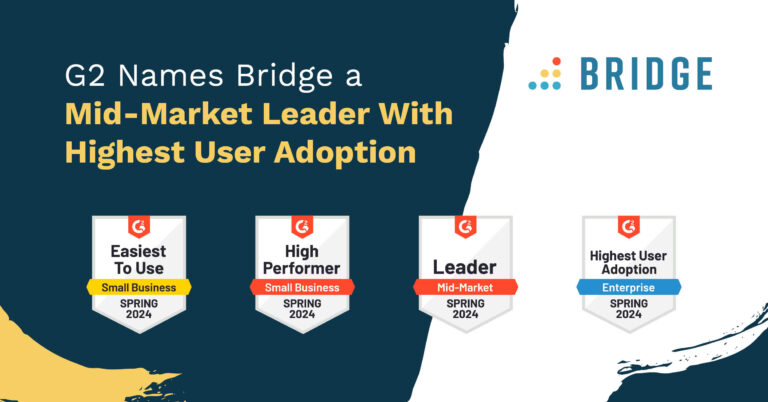Explore the relationship between your HR platform and people and organizational performance, as well as your managers’ role in driving this success through employee training and development.
Your managers are one of your greatest allies in your employee development, productivity, and employee engagement initiatives.
Enabling your people to guide their teams in their goals and support career progression requires an environment that promotes collaboration and ongoing communication.
Read on to find out how an all-in-one learning and performance platform can lead to increased accountability and forge stronger ties within their teams.
Do Your Managers Have the Tools to Do Their Job?
Your managers play a pivotal role in your talent development initiatives, and the systems and technologies your organization relies on can either help or hinder them in this mission.
Research compiled by Asana explores the critical role of technology within organizations, and unsurprisingly, the results show that a cumbersome set of tools and technologies negatively impacts managers and leaders. When systems and software are disconnected and processes are inefficient, they find it challenging to track goals and communicate with teams.
Additionally, in companies where people use ten or more apps as part of their daily workflow, managers and leaders share the following sentiments:
- 47% feel it’s challenging to work cross-functionally
- 26% say they’re less efficient as a result of app-switching
- 25% report missing important messages and action items
What’s clear is that using too many tools or having a poorly integrated tech stack is overwhelming and takes managers away from their core responsibilities.
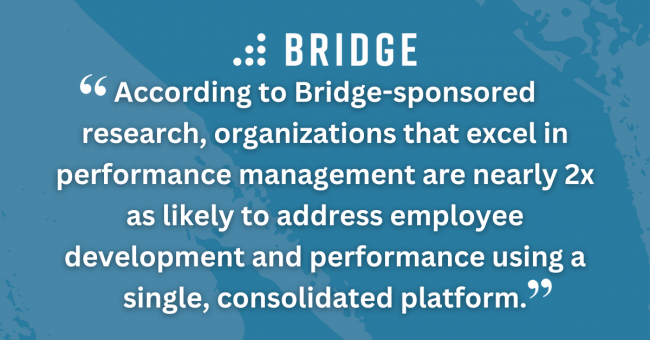
How Bridge, an All-In-One Learning, Skills, and Performance Tool Enables Managers
For your software to add value, it should address a business challenge and help your people do the things they need to.
As responses from HR professionals indicate in the Bridge-sponsored Future of Performance Management report, managers are a driving force behind organization-wide performance. Companies that take active steps to enable manager-employee connection and conversation experience several benefits.
Specifically, high-performing organizations that achieve all of their goals adopt similar processes and approaches to technology, including:
- They’re over three times as likely to view employee development and growth as connected to performance
- They’re almost three times as likely to track one-on-ones, coaching conversations, and feedback as part of the performance process
- They’re nearly twice as likely to use one platform that integrates with existing tools and data to address employee development and performance
Scaling back your technology doesn’t mean compromising the user experience. A comprehensive employee development tool like Bridge brings your employee learning and performance initiatives together, supporting your managers with data that empowers decisions and drives conversations. With one easy-to-use platform, you give them actionable ways to guide people and put human connection at the heart of the employee experience.
Here are six ways Bridge’s integrated HR tech stack empowers your managers.
HOW TO ADDRESS YOUR EMPLOYEE DEVELOPMENT INITIATIVES WITH ONE SOLUTION | ‘Consolidate Your HR Tools: How All Your Employee Development Initiatives Can Be Done in Bridge’
1) Conduct Tactical Manager-Employee One-on-Ones
It's no secret that regularly connecting with a manager keeps employee engagement, productivity, and retention rates high. A platform that threads communication and feedback into interactions while keeping goals and priorities visible can strengthen engagement and maintain alignment.
An all-in-one learning and performance management platform like Bridge assists your managers with their mission in several ways. The ability to schedule and track one-on-ones with recorded agendas takes them from a tick-box exercise to a productive weekly meeting for employees and line managers to discuss current priorities, recent challenges and successes, and future actions.
During these check-ins, the combination of learning and performance insights gives managers the depth and clarity to offer constructive feedback. They can also guide training based on the results of skills development and growth initiatives within the context of the conversation.
In the same platform, managers have the power to enroll their people in courses, check on goals, and use the agenda to check they’ve covered all action items. And with the ability to serve conversation prompts and suggestions to managers within the one-on-one template, you help them develop their conversation skills, all while keeping discussions focused and tactical.
2) Streamline Admin and Provide In-Depth Data
Managers are busy, and with competing priorities, they need a way to speed up repetitive tasks and track key objectives and metrics in real time.
Tying your organization's performance data into an agile platform with access to learning, career, and skills data offers a high-level overview of their teams in a given moment.
With everything in one place, managers can ensure they're playing their part toward driving organizational goals by accessing team progress, individual progress, and learning completion rates, as well as regularly checking they're conducting one-on-ones. They're able to provide timely feedback or praise, adjust goals, and find areas where employees might need support at a given time.
Integrating your existing tools with a learning platform also assists managers with day-to-day tasks. By automating one-on-one scheduling and providing customizable conversation and evaluation templates, you cut out the work involved in managing processes. You can also automate the flow of data from a source of truth, such as an HRIS, keeping your employee data relevant and current.
UNCOVER MORE WAYS TO LEVERAGE ANALYTICS | ‘The Power of Learning Analytics to Drive Decisions and Growth’
3) Personalize the Performance Review Process
Access to a tool that encourages communication benefits the performance management process, as it makes goal-tracking, feedback, and conversation year-round initiatives.
With multiple sources of input assessing employees and providing feedback, managers get a rounded picture of performance and growth. They're able to tap into learning and skills insights from across the business, giving them a three-dimensional image of their people alongside the information they've compiled.
Making this information visible reduces the time it takes managers to complete performance reviews and leads to in-depth, personalized performance conversations that guide people toward meaningful development goals. This continuous performance management approach means that there are no surprises for employees, as they know exactly where they are and where they're heading.
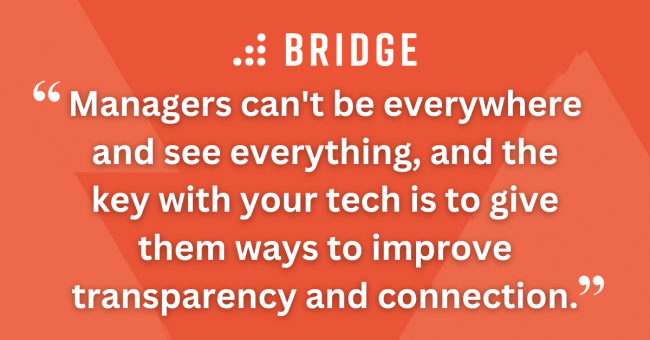
4) Close Skills and Competency Gaps
Using a single system like Bridge to bring learning, skills, and performance insights together means managers play a proactive role in employee skills development informed by data. This helps them collaborate with employees to create targeted training and development plans that align with individual skills gaps and business demands.
Within Bridge, AI-driven skills insights connect your employees' job titles to relevant skills and competencies based on dynamic market data, making these suggestions more personalized. Your people can use these recommendations to search for training and ask peers and managers to assess their mastery via assessments and feedback.
Managers can't be everywhere and see everything, and the key with your tech is to give them ways to improve transparency and connection. By unearthing skills-based insights through feedback, managers get a snapshot of each employee's strengths and weaknesses, the areas to focus development, and how their review compares to the average.
Once an entire team has been assessed anonymously, managers are presented with a visualization of their teams' strengths and weaknesses. They can use this information to check that current skillsets align with the tasks at hand and assign work based on each employee's strengths.
5) Guide Employees Toward Their Career Development Goals
Not all employees will likely have a clear idea about their development goals or the future roles they want to move into. Career conversations are a way to clarify a future vision within your organization and help people establish a set of goals and development actions.
Managers have a deep understanding of their people's strengths and motivations along with strong interpersonal skills, making them ideally suited to conduct these discussions. With access to employee learning and performance data, they can start more productive career conversations, and use the time to create and review employee development plans.
These discussions should be personal, using employees' unique motivations as the starting point. From here, they can outline the necessary skills to develop and refine the roles they'll advance into to achieve their career vision.
Within Bridge's platform, managers can access a series of prompts and exercises to guide employees through a step-by-step career vision. In addition, the Bridge Career Drivers card game helps uncover deeper motivations about motivations and goals.
DISCOVER WHAT DRIVES YOUR EMPLOYEES IN THREE STEPS | ‘A 3-Step Workbook for Managers to Find Out What Drives Their People’
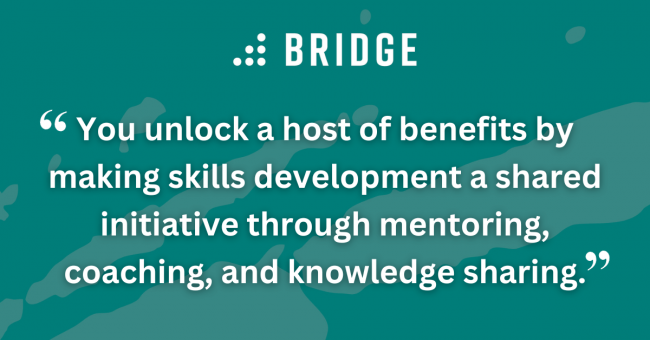
6) Make Skills Development a Company-Wide Initiative
Research suggests that when managers actively connect their employees to skilled mentors and peers, it makes their jobs more manageable and improves employee performance by up to 45%.
You unlock a host of benefits by making skills development a shared initiative through mentoring, coaching, and knowledge sharing. A learning and performance platform can support managers in developing their people by finding and connecting employees to talent outside their immediate team and department.
Combining your talent development tools and processes makes it easy for managers to support employee upskilling or reskilling. When they identify a training need, they can immediately assign on-demand multimodal content courses from the learning library based on a skills gap or find willing mentors and coaches to support employee development.
Using a learning platform that serves people with targeted training recommendations based on the skills they want to develop means learners can take the lead and seek out mentors or look for peer-based learning opportunities through cohorts and communities. When they find a suitable coach or mentor, a one-on-one agenda keeps training on track and shows managers how their teams are progressing.
MORE ABOUT MENTORING | ‘3 Ways to Maintain an Effective Corporate Mentoring Program’
Equip Your Managers for Success With Bridge’s LMS
With Bridge, you only need a single tool to handle your learning, development, and skills needs. Equipping your managers with an all-in-one solution gives them an advantage in driving employee development and engaging people in tactical conversation.
Bridge offers an award-winning learning management system and performance platform in one unified experience. Employee development and engagement are at the heart of everything we do. Design and deliver training programs, and take learning to a new level with tools designed to make conversations about workplace performance easier.
Bridge has helped thousands of organizations worldwide drive growth by bringing learning, skill-building, and employee engagement together in one easy-to-use platform.
